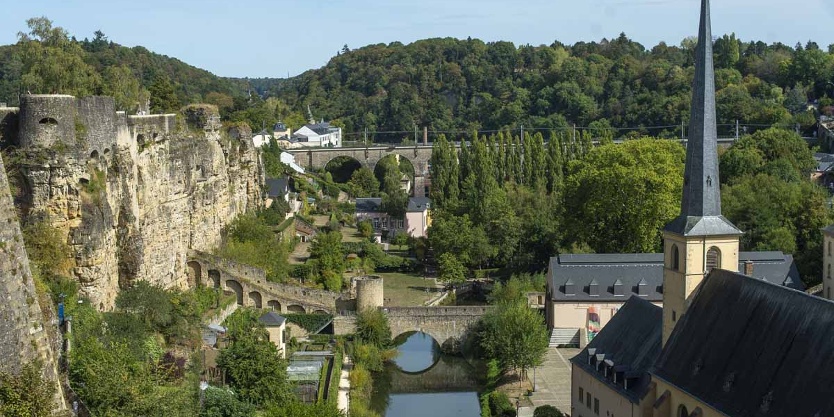Bock Casemates (Casemates du Bock) – A Journey Through History:
One of Luxembourg’s most iconic landmarks is the Bock Casemates, a vast network of underground tunnels and fortifications built into the cliffs of the Bock promontory. This UNESCO World Heritage site is a testament to the country’s military history, dating back to the 17th century. The casemates were originally constructed by the Spanish in the 1600s, then expanded and fortified by the French in the 18th century. They served as defensive structures designed to protect the city from invaders.
Visitors can explore over 17 kilometers of tunnels, which were once part of an elaborate system of fortifications that connected various parts of the city. Walking through these cool, dark passageways, visitors can learn about Luxembourg’s strategic importance and the various military campaigns that shaped the city. The panoramic views from the top of the Bock cliffs are also breathtaking, offering a view of Luxembourg City, its historic center, and the surrounding valleys.
Highlights:
- Underground tunnels and military fortifications.
- Historical exhibitions and multimedia displays.
- Spectacular views of Luxembourg City from the Bock promontory.

The Old Town of Luxembourg City (Ville Haute) – A UNESCO World Heritage Treasure:
The heart of Luxembourg City lies in its Old Town, known as Ville Haute. This historic district is a blend of medieval and modern architecture, with cobblestone streets, charming squares, and magnificent buildings. The Old Town is a UNESCO World Heritage site, and it offers a stunning look at Luxembourg’s history and culture.
Among the highlights in the Old Town is the Grand Ducal Palace, the official residence of the Grand Duke of Luxembourg. Visitors can take a guided tour of the palace during the summer months to learn about the country’s monarchy and the role of the Grand Ducal family. The Place Guillaume II is another prominent square in the Old Town, home to the striking City Hall and a statue of William II, the king of the Netherlands, who also ruled Luxembourg.
In addition to historical buildings, Ville Haute is dotted with museums, cafes, and boutiques, making it a wonderful place to explore on foot. The Notre-Dame Cathedral, a masterpiece of Gothic architecture, is another must-see.
Highlights:
- Grand Ducal Palace and guided tours.
- Medieval streets and charming squares.
- Notre-Dame Cathedral and other historic landmarks.
Mullerthal Region – Luxembourg’s Little Switzerland:
For nature lovers, the Mullerthal Region, often called “Luxembourg’s Little Switzerland,” is an unmissable attraction. Located in the eastern part of the country, this area is famous for its stunning rock formations, lush forests, and picturesque landscapes. The Mullerthal Trail, one of the most popular hiking routes in Luxembourg, winds its way through this rugged terrain, offering spectacular views, ancient woodlands, and dramatic cliffs.
The region is characterized by unique sandstone rock formations and hidden caves, which make it a paradise for outdoor enthusiasts. The Schiessentümpel Waterfall and the Perekop are two popular natural spots worth visiting. The area also features quaint villages, such as Beaufort, known for its medieval Beaufort Castle, which offers a glimpse into Luxembourg’s medieval past.
Whether you’re hiking, cycling, or simply enjoying the peaceful surroundings, the Mullerthal Region is perfect for anyone wanting to experience Luxembourg’s natural beauty.
Highlights:
- Mullerthal Trail – a scenic 112 km hiking route.
- Unique rock formations, caves, and waterfalls.
- Beautiful nature and charming villages like Beaufort.





